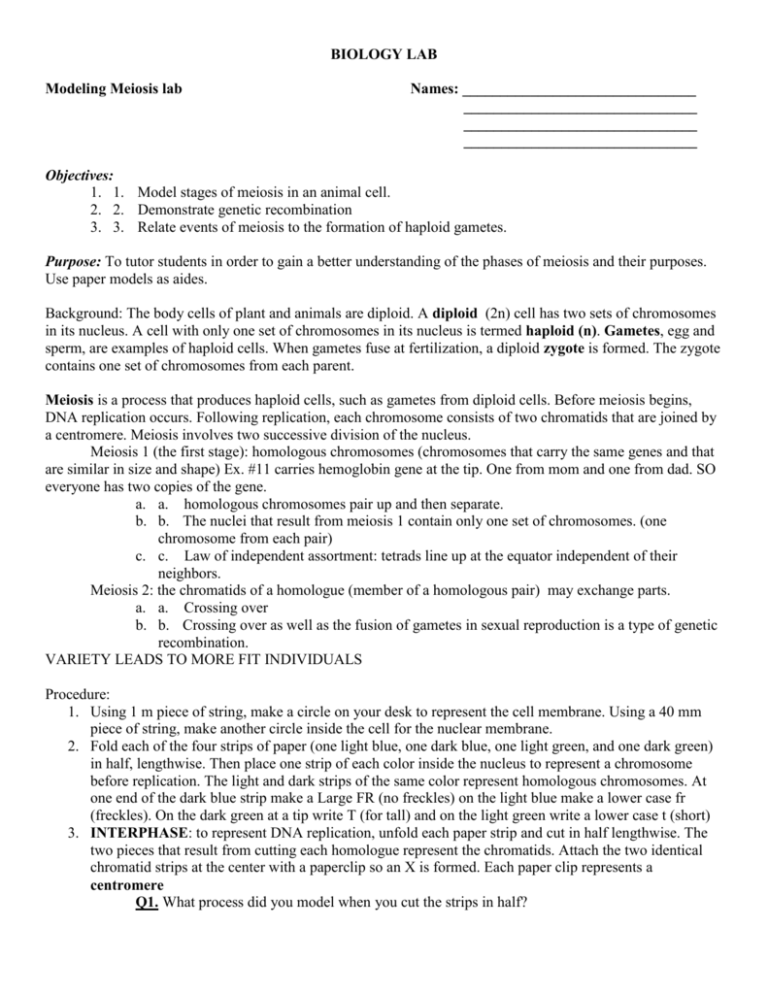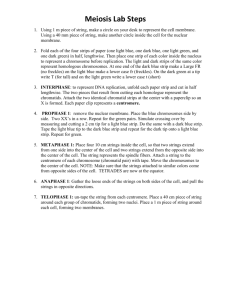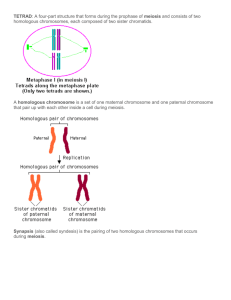Modeling Meiosis lab
advertisement

BIOLOGY LAB Modeling Meiosis lab Names: _______________________________ _______________________________ _______________________________ _______________________________ Objectives: 1. 1. Model stages of meiosis in an animal cell. 2. 2. Demonstrate genetic recombination 3. 3. Relate events of meiosis to the formation of haploid gametes. Purpose: To tutor students in order to gain a better understanding of the phases of meiosis and their purposes. Use paper models as aides. Background: The body cells of plant and animals are diploid. A diploid (2n) cell has two sets of chromosomes in its nucleus. A cell with only one set of chromosomes in its nucleus is termed haploid (n). Gametes, egg and sperm, are examples of haploid cells. When gametes fuse at fertilization, a diploid zygote is formed. The zygote contains one set of chromosomes from each parent. Meiosis is a process that produces haploid cells, such as gametes from diploid cells. Before meiosis begins, DNA replication occurs. Following replication, each chromosome consists of two chromatids that are joined by a centromere. Meiosis involves two successive division of the nucleus. Meiosis 1 (the first stage): homologous chromosomes (chromosomes that carry the same genes and that are similar in size and shape) Ex. #11 carries hemoglobin gene at the tip. One from mom and one from dad. SO everyone has two copies of the gene. a. a. homologous chromosomes pair up and then separate. b. b. The nuclei that result from meiosis 1 contain only one set of chromosomes. (one chromosome from each pair) c. c. Law of independent assortment: tetrads line up at the equator independent of their neighbors. Meiosis 2: the chromatids of a homologue (member of a homologous pair) may exchange parts. a. a. Crossing over b. b. Crossing over as well as the fusion of gametes in sexual reproduction is a type of genetic recombination. VARIETY LEADS TO MORE FIT INDIVIDUALS Procedure: 1. Using 1 m piece of string, make a circle on your desk to represent the cell membrane. Using a 40 mm piece of string, make another circle inside the cell for the nuclear membrane. 2. Fold each of the four strips of paper (one light blue, one dark blue, one light green, and one dark green) in half, lengthwise. Then place one strip of each color inside the nucleus to represent a chromosome before replication. The light and dark strips of the same color represent homologous chromosomes. At one end of the dark blue strip make a Large FR (no freckles) on the light blue make a lower case fr (freckles). On the dark green at a tip write T (for tall) and on the light green write a lower case t (short) 3. INTERPHASE: to represent DNA replication, unfold each paper strip and cut in half lengthwise. The two pieces that result from cutting each homologue represent the chromatids. Attach the two identical chromatid strips at the center with a paperclip so an X is formed. Each paper clip represents a centromere Q1. What process did you model when you cut the strips in half? Q2. What is the function of the centromere? 4. PROPHASE 1: remove the nuclear membrane. Place the blue chromosomes side by side. Two XX’s in a row. Repeat for the green pairs. Simulate crossing over by measuring and cutting a 2 cm tip for a light blue strip. Do the same with a dark blue strip. Tape the light blue tip to the dark blue strip and repeat for the dark tip onto a light blue strip. Repeat for green. Dark Blue Light Blue Dark Green Light Green Q3. What is the purpose of placing the light and dark strips of the same color side by side? 5. METAPHASE 1: Place four 10 cm strings inside the cell, so that two strings extend from one side into the center of the cell and two strings extend from the opposite side into the center of the cell. The string represents the spindle fibers. Attach a string to the centromere of each chromosome (chromatid pair) with tape. Move the chromosomes to the center of the cell. NOTE: Make sure that the strings attached to similar colors come from opposite sides of the cell. TETRADES are now at the equator. 6. ANAPHASE 1: Gather the loose ends of the strings on both sides of the cell, and pull the strings in opposite directions. 7. TELOPHASE 1: un-tape the string from each centromere. Place a 40 cm piece of string around each group of chromatids, forming two nuclei. Place a 1 m piece of string around each cell, forming two membranes. Q4. How many chromosomes are in each cell? Describe what each part represents. MEIOSIS 2 8. PROPHASE 2: Remove the strings that represent the nuclear membrane and the cell membranes in both cells. Attach a 10 cm piece of string to each chromatid. Q5. What must happen before the chromatids to separate? 9. METAPHASE 2: Move the chromosomes to the center of each cell. Make sure the strings attached to the two strips in each chromosome come from opposite sides of the cell. 10. ANAPHASE 2: Gather the strings on both sides of each cell, and pull the strings in opposite directions, separating the paper strips. Note: Only one strip in each pair will have a paper clip attached. 11. TELOPHASE 2: Untape the strings. Remove the strings and paper clips. Each strip of paper now represents a chromosome. Place a 40-cm. piece of string around each group of chromosomes, forming four nuclei. Place a 1m string around each cell, forming four membranes. Q6: How many cells did you make? How many chromosomes are in each cell? Are the cells haploid or diploid in number? Analysis: Q7. What is the diploid chromosome number of the original cell in your model? How many homologous pairs does this represent? Q8. If a cell with a diploid number of 6 chromosomes undergoes meiosis, what will the cell look like after Telophase 1? Draw the result below: Q9. Give two reasons why meiosis is important in sexual reproduction. Q10. How might crossing over affect the rate of evolution? Q11. Use your model to show what would happen if homologous chromosomes did not pair in Prophase 1. Predict the outcome. Home








